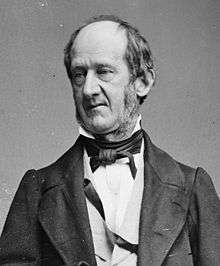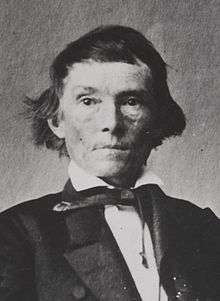United States House of Representatives elections, 1850
| | |||||||||||||||||||||||||||||||||||||||||||||||||||||||||||||||||||||||
| |||||||||||||||||||||||||||||||||||||||||||||||||||||||||||||||||||||||
| |||||||||||||||||||||||||||||||||||||||||||||||||||||||||||||||||||||||
| |||||||||||||||||||||||||||||||||||||||||||||||||||||||||||||||||||||||
Elections to the United States House of Representatives for the 32nd Congress were held at various dates in each state from August 5, 1850 (Iowa and Missouri) to November 4, 1851 (Louisiana and Mississippi). The Democrats gained 17 seats, increasing their majority relative to the Whigs, who lost 22 seats.
Whig President Millard Fillmore, who had gained the presidency after the death of Zachary Taylor, grew increasingly unpopular. The election saw sectionalism and slavery continue to emerge as major issues.
The Constitutional Union Party, formed in support of the Compromise of 1850, gained 10 seats (its first ever) in Georgia, Mississippi, and Alabama. The Free Soil Party, which was strongly abolitionist, lost five seats and was reduced to four Representatives, all in New England districts. The States' Rights Party, a pro-slavery states' rights party, gained ground in Georgia and Mississippi.
Election summaries
| 130 | 10 | 3 | 4 | 86 |
| Democratic | CU | SR | FS | Whig |
| State | Type | Date | Total seats |
Democratic | Whig | Constitutional Union | Free Soil | States' Rights | |||||
|---|---|---|---|---|---|---|---|---|---|---|---|---|---|
| Seats | Change | Seats | Change | Seats | Change | Seats | Change | Seats | Change | ||||
| Illinois | District | November 5, 1850 (Election Day)[Note 3] |
7 | 6 | 1 | 0 | 0 | 0 | |||||
| Michigan | District | 3 | 1 | 2 | 0 | 0 | 0 | ||||||
| New Jersey | District | 5 | 4 | 1 | 0 | 0 | 0 | ||||||
| New York | District | 34 | 17 | 17 | 0 | 0 | 0 | ||||||
| Wisconsin | District | 3 | 2[Note 4] | 0 | 0 | 1 | 0 | ||||||
| Delaware | At-large | November 12, 1850 | 1 | 1 | 0 | 0 | 0 | 0 | |||||
| Florida | At-large | October 7, 1850 | 1 | 0 | 1 | 0 | 0 | 0 | |||||
| Iowa | District | August 5, 1850 | 2 | 2 | 0 | 0 | 0 | 0 | |||||
| Maine | District | September 9, 1850 | 7 | 5 | 2 | 0 | 0 | 0 | |||||
| Massachusetts | District | November 11, 1850 | 10[Note 5] | 1 | 7 | 0 | 2 | 0 | |||||
| Missouri | District | August 5, 1850 | 5 | 2 | 3 | 0 | 0 | 0 | |||||
| Ohio | District | October 8, 1850 | 21 | 11[Note 4] | 9 | 0 | 1 | 0 | |||||
| Pennsylvania | District | October 8, 1850 | 24[Note 6] | 15 | 9 | 0 | 0 | 0 | |||||
| South Carolina | District | October 14–15, 1850 | 7 | 7 | 0 | 0 | 0 | 0 | |||||
| Vermont | District | September 3, 1850 | 4 | 1 | 3 | 0 | 0 | 0 | |||||
| 1851 elections | |||||||||||||
| Alabama | District | August 4, 1851 | 7 | 4 | 2 | 1 | 0 | 0 | |||||
| Arkansas | At-large | August 4, 1851 | 1 | 1 | 0 | 0 | 0 | 0 | |||||
| California | At-large | September 3, 1851 | 2[Note 7] | 2 | 0 | 0 | 0 | 0 | |||||
| Connecticut | District | April 7, 1851 | 4 | 3 | 1 | 0 | 0 | 0 | |||||
| Georgia | District | October 6, 1851 | 8 | 0 | 0 | 6 | 0 | 2 | |||||
| Indiana | District | August 4, 1851 | 10 | 8 | 2 | 0 | 0 | 0 | |||||
| Kentucky | District | August 4, 1851 | 10 | 5 | 5 | 0 | 0 | 0 | |||||
| Louisiana | District | November 4, 1851 | 4 | 2 | 2 | 0 | 0 | 0 | |||||
| Maryland | District | October 1, 1851 | 6 | 2 | 4[Note 2] | 0 | 0 | 0 | |||||
| Mississippi | District | November 3–4, 1851 | 4 | 0 | 0 | 3 | 0 | 1 | |||||
| New Hampshire | District | March 11, 1851 | 4 | 2 | 2 | 0 | 0 | 0 | |||||
| North Carolina | District | August 7, 1851 | 9 | 3 | 6 | 0 | 0 | 0 | |||||
| Rhode Island | District | April 2, 1851 | 2 | 1 | 1 | 0 | 0 | 0 | |||||
| Tennessee | District | August 7, 1851 | 11 | 7[Note 4] | 4 | 0 | 0 | 0 | |||||
| Texas | District | August 4, 1851 | 2 | 2 | 0 | 0 | 0 | 0 | |||||
| Virginia | District | October 23, 1851 | 15 | 13 | 2 | 0 | 0 | 0 | |||||
| Total | 233 | 130[Note 1] 55.8% |
|
86[Note 2] 36.9% |
|
10 4.3% |
|
4 1.7% |
|
3 1.3% |
| ||
One district in Massachusetts had been vacant in the 31st Congress. No new seats were added. The previous election had 1 Know-Nothing and 1 Independent
Complete returns
California
| District | Incumbent | Party | First elected |
Result | Candidates |
|---|---|---|---|---|---|
| California at-large | George W. Wright | Independent | 1849 | Democratic gain | Edward C. Marshall (D) Joseph W. McCorkle (D) |
| Edward Gilbert | Democratic | 1849 | Democratic hold |
Florida
| District | Incumbent | Party | First elected |
Result | Candidates |
|---|---|---|---|---|---|
| Florida at-large | Edward C. Cabell | Whig | 1846 | Re-elected | Edward C. Cabell (W) 52.8% John Beard (D) |
See also
Notes
- 1 2 Includes three Independent Democrats from Ohio, Tennessee, and Wisconsin.
- 1 2 3 Includes 1 Independent Whig.
- ↑ In 1845, Congress passed a law providing for a uniform date for choosing presidential electors (see: Statutes at Large, 28th Congress, 2nd Session, p. 721). Congressional elections were unaffected by this law, but the date was gradually adopted by the states for Congressional elections as well.
- 1 2 3 Includes one Independent Democrat.
- ↑ One seat (MA-04) had been vacant during the entire 31st Congress.
- ↑ There was 1 Know-Nothing in the 31st Congress.
- ↑ There was 1 Independent in the 31st Congress.
Bibliography
- Dubin, Michael J. (March 1, 1998). United States Congressional Elections, 1788-1997: The Official Results of the Elections of the 1st Through 105th Congresses. McFarland and Company. ISBN 978-0786402830.
- Martis, Kenneth C. (January 1, 1989). The Historical Atlas of Political Parties in the United States Congress, 1789-1989. Macmillan Publishing Company. ISBN 978-0029201701.
- Moore, John L., ed. (1994). Congressional Quarterly's Guide to U.S. Elections (Third ed.). Congressional Quarterly Inc. ISBN 978-0871879967.
- "Party Divisions of the House of Representatives* 1789–Present". Office of the Historian, House of United States House of Representatives. Retrieved January 21, 2015.
External links
- Office of the Historian (Office of Art & Archives, Office of the Clerk, U.S. House of Representatives)




